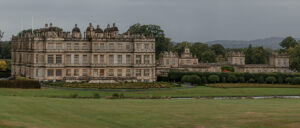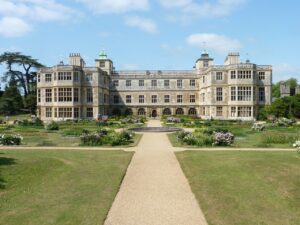10 lovely stately homes
Nothing says life in Britain better than a sunny day out exploring the country’s stunning stately homes
Belvoir Castle
One of the most magnificent and beautiful Regency stately homes in Britain, Belvoir Castle is the ancestral home if the Dukes of Rutland, whose family has lived at Belvoir in an unbroken line for almost a thousand years.
Crowning a hill in Leicestershire, its turrets and towers rise over the Vale of Belvoir like an illustration in a romantic fairytale. The first castle which was begun in 1067, and by 1464 the Wars of the Roses had taken their toll on the building and it was more or less in ruins. Some 60 years later it rose again, but as a nobler structure with a central courtyard, parts of which can still be recognised today. But in 1649 that too was destroyed, by Parliamentarians after Royalists had seized it during the Civil War. Its third incarnation, began in 1654 was designed as a large family home with no connotations of defence or war. The castle you see today finally emerged in the early 1800s and was built for the 5th Duke and Duchess of Rutland between 1801 and 1832 by architect James Wyatt. The castle was given the French name Belvoir – meaning beautiful view – now pronounced ‘beaver’.
Belvoir is open on selected dates from March to September.
Blenheim Palace
A true masterpiece of Baroque architecture, a visit to Blenheim Palace is an awe-inspiring experience. It was built in the early 18th century to celebrate victory over the French in the War of the Spanish Succession. In particular, it was built as a gift to the 1st Duke of Marlborough, John Churchill, the military commander who led the Allied forces in the Battle of Blenheim on 13 August 1704. Marlborough himself received the surrender from Marshall Tallard, leader of the French forces, following the battle.
To honour the Duke’s heroic victories, Queen Anne granted his family the ruined Royal Manor and park at Woodstock, along with £240,000 with which to build a house to mark the occasion. Blenheim Palace was designed by Sir John Vanbrugh. Despite an inscription on the Palace wall stating that it was built between 1705 and 1722, the Chapel (the last part of the Palace to be built) was not consecrated until 1733, 11 years after the death of the 1st Duke. Landscape architect Lancelot ‘Capability’ Brown was commissioned to re-landscape the more than 2000 acres of surrounding Parkland.
The palace is open daily.
Highclere
A Jacobethan style country house, Highclere Castle in Hampshire, is these days most famous as the location for the fictional Downton Abbey. The 5,000 acre estate has parkland designed by Capability Brown. A medieval palace built during the 12th and 13th century existed on the site which was later succeeded by a much admired red brick Tudor house.
Major rebuilding works were carried out in the late 18th and early 19th centuries by the Carnarvon family and the old red brick and freestone house was converted to a classical Georgian mansion within a pastoral setting. The major transformation, however, was just about to happen. In 1838, the 3rd Earl of Carnarvon brought in Sir Charles Barry to transform his home into a grand mansion which would impress the world.
The new “Highclere Castle” dominated its surroundings in a most dramatic way. No wonder Benjamin Disraeli’s first words on seeing Highclere were “How scenical! How scenical!”.
Various tours are available. Visit the website for more details.
Burghley House
Built by Queen Elizabeth’s Lord High Treasurer, Burghley House, a grand 16th-century country house near Stamford, Lincolnshire, is a leading example of the Elizabethan prodigy house. The building of the house took some 32 years. Sir William Cecil had purchased Theobalds Manor, Hertfordshire in 1563 and for a whole decade was fully engaged there in the building of his great ‘prodigy’ house.
At Burghley in August 1564, Edmund Hall, the surveyor, promised that the south side should be finished by winter. Thereafter, little more work was done until 1575 when the team of masons was reassembled. The west front with its great gate-house (it was originally intended to be the main entrance) was finished in 1577. The north front was completed in 1587. Today, it has parkland laid out by Capability Brown.
Burghley House is open daily.
Montacute House A masterpiece of Elizabethan Renaissance architecture and design. With its towering walls of glass, glow of ham stone, and its surrounding gardens it is a place of beauty and wonder. It os one of few prodigy houses to survive almost unchanged from the Elizabethan era.
A masterpiece of Elizabethan Renaissance architecture and design. With its towering walls of glass, glow of ham stone, and its surrounding gardens it is a place of beauty and wonder. It os one of few prodigy houses to survive almost unchanged from the Elizabethan era.
Sir Edward Phelips, was the visionary force and money behind the creation of this masterpiece, which was completed in 1601. Built by skilled craftsman using local ham stone under the instruction of William Arnold, master mason, the house was a statement of wealth, ambition and showmanship.
Come face to face with the past in the Long Gallery, which is the longest of its kind in England. The gallery houses over 60 Tudor and Elizabethan portraits on loan from the National Portrait Gallery.
See the website for opening times.
Chatsworth House
Chatsworth is home to the Duke and Duchess of Devonshire, and has been passed down through 16 generations of the Cavendish family. Renowned for the quality of its art, landscape and hospitality, the house has evolved through the centuries to reflect the tastes, passions and interests of succeeding generations of the family. Today Chatsworth contains works of art that span 4,000 years, from ancient Roman and Egyptian sculpture, and masterpieces to modern art.
Chatsworth is open year round.
Castle Howard
So ambitious was the vision for Castle Howard, the private residence of the Howard family for more than 300 years, that the Baroque building took over 100 years to complete but the result was astounding, with two symmetrical wings and a central dome.
Although much of the building was devastated by fire in the 1940s, over the years many rooms have been restored, though when the house was used as the backdrop for the film version of Evelyn Waugh’s Brideshead Revisited in 2008 parts were superficially restored and the East Wing remains a shell.
Castle Howard is open daily.
Longleat
Completed in 1580, Longleat is another of our great Elizabethan houses, set in 900 acres of parkland landscaped by Capability Brown. Inside you’ll find one of the largest book collections in Europe and the bloodstained waistcoat King Charles I was wearing when he was executed in 1649, which sits in the Great Hall.
Now home to the 7th Marquess of Bath and run by his son, Viscount Weymouth, it’s come a long way from the property bought by MP John Thynne in 1540 for £53, and packed with a range of attractions.
Longleat is open daily.

Hatfield House
Hatfield House, the home of the Marquess of Salisbury, is 16th-century grand Jacobean stately home and gardens built by Robert Cecil, the first Earl of Salisbury and son of Lord Burghley, the chief minister of Elizabeth I, on the site of her childhood home. The estate has been in the Cecil family for 400 years.
The deer park surrounding the house and the older building of the Old Palace had been owned by Elizabeth’s father, Henry VIII, who had used it as a home for his children, Edward, Elizabeth and Mary. It was while she was living in the Old Palace, in 1558, that Elizabeth learned of her accession to the throne.
Superb examples of Jacobean craftsmanship can be seen throughout Hatfield House such as the Grand Staircase with its fine carving and the rare stained glass window in the private chapel.
Opens March until September, Wednesday to Sunday and Bank Holiday Mondays.
Audley End
Audley End House is a largely early 17th-century country house outside Saffron Walden, Essex. It was once a prodigy house, a palace in all but name and renowned as one of the finest Jacobean houses in England.
The impressive house that can be seen today is only about a third the size of the vast mansion created in about 1605-14 by Thomas Howard, 1st Earl of Suffolk. It retains much of its original character, and contains fine Robert Adam and Jacobean revival interiors. The gardens and landscape, shaped by various owners to complement the house, reflect many changes in English garden fashion.
Audley End is open year round.
Read more:

